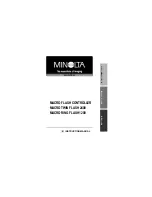
27
26
1. Turn camera on and set to A
mode or M mode.
2. Turn the flash on by pressing
the flash on/off button. The
flash-on lamp will glow.
4. When using M mode, select a
shutter speed that is slower
than the camera’s sync speed.
3. Focus your subject and check
the magnification ratio.
• The location of the magnification ratio
scale differs, depending on which
lens is used.
5. Select an aperture. Refer to the
tables on pages 30 to 32.
BASIC FLASH MODES
Camera’s exposure mode should be set to either A (aper-
ture priority) mode*, or M (manual) mode**.
Depth-of-field*** is quite shallow at close-up and macro ranges, so
focusing is very important. It is recommended that you use a macro
lens and select an aperture as small as practical to maximize the
depth-of-field.
In this section, the basic flash operation in A or M mode with TTL
metering (TTL lamp on) is described.
*A mode: In A mode, you select the aperture and the camera
automatically sets the shutter speed required for proper exposure.
**M mode: You can select both aperture or shutter speed. HSS (high-
apeed sync) is not possible.
***Depth-of-field: The range behind and in front of the subject that
appears sharp.
This part of the manual assumes that the user is using one of
the following cameras and macro lens.
Camera: A camera having A mode (aperture priority) or M mode
(manual).
Lens:
AF 50mm f/2.8 Macro
AF 50mm f/2.8 (D) Macro
AF 50mm f3.5 Macro
AF 100mm f/2.8 Macro
AF 100mm f/2.8 (D) Macro
AF 200mm f/4 Macro Apo G
AF Macro Zoom 3X-1X f/1.7-2.8
If you use a camera other than one listed above, refer to P mode
flash section (p. 33). If using a different lens, see pages 60 and 62.
Continued on next page















































